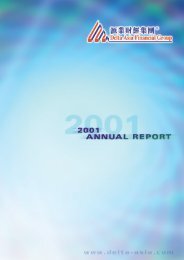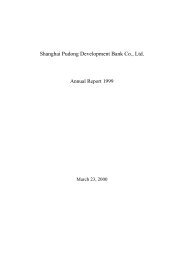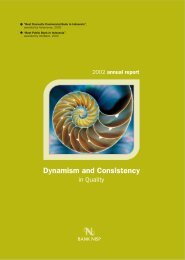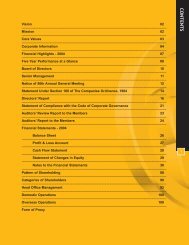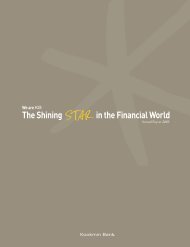Banco de Oro Universal Bank provides a - Asianbanks.net
Banco de Oro Universal Bank provides a - Asianbanks.net
Banco de Oro Universal Bank provides a - Asianbanks.net
- No tags were found...
Create successful ePaper yourself
Turn your PDF publications into a flip-book with our unique Google optimized e-Paper software.
2005 ANNUAL REPORT433.18 Impairment of financial assetsThe Group assesses at each statement of condition date whether there is objective evi<strong>de</strong>nce that a financial asset or group of financial assetsis impaired. A financial asset or a group of financial assets is impaired and impairment losses are incurred if, and only if, there is objectiveevi<strong>de</strong>nce of impairment as a result of one or more events that occurred after the initial recognition of the asset (a loss event) and that lossevent has an impact on the estimated future cash flows of the financial asset or group of financial assets that can be reliably estimated.Objective evi<strong>de</strong>nce that a financial asset or group of assets is impaired inclu<strong>de</strong>s observable data that comes to the attention of the Groupabout certain loss events, including, among others: significant financial difficulty of the issuer or <strong>de</strong>btor; a breach of contract, such as a <strong>de</strong>faultor <strong>de</strong>linquency in interest or principal payments; it is probable that the borrower will enter bankruptcy or other financial reorganization; thedisappearance of an active market for that financial asset because of financial difficulties; or observable data indicating that there is ameasurable <strong>de</strong>crease in the estimated future cash flows from a group of financial assets since the initial recognition of those assets, althoughthe <strong>de</strong>crease cannot yet be i<strong>de</strong>ntified with the individual financial assets in the group.• Assets carried at amortized cost. The Group first assesses whether objective evi<strong>de</strong>nce of impairment exists individually for financialassets that are individually significant and individually or collectively for financial assets that are not individually significant. If theGroup <strong>de</strong>termines that no objective evi<strong>de</strong>nce of impairment exists for an individually assessed financial asset, whether significant ornot, the Group inclu<strong>de</strong>s the asset in a group of financial assets with similar credit risk characteristics and collectively assesses themfor impairment. Assets that are individually assessed for impairment and for which an impairment loss is or continues to berecognized are not inclu<strong>de</strong>d in a collective assessment of impairment.If there is objective evi<strong>de</strong>nce that an impairment loss on loans and receivable or held-to-maturity investments carried at amortizedcost has been incurred, the amount of the loss is measured as the difference between the asset’s carrying amount and the presentvalue of estimated future cash flows (excluding future credit losses that have not been incurred) discounted at the financial asset’soriginal effective interest rate. The carrying amount of the asset is reduced through the use of an allowance account and theamount of the loss is recognized in the statements of income. If a loan or held-to-maturity investment has a variable interest rate,the discount rate for measuring any impairment loss is the current effective interest rate <strong>de</strong>termined un<strong>de</strong>r the contract. Whenpracticable, the Group may measure impairment on the basis of an instrument’s fair value using an observable market price.The calculation of the present value of the estimated future cash flows of a collateralized financial asset reflects the cash flows thatmay result from foreclosure less costs for obtaining and selling the collateral, whether or not foreclosure is probable.For the purpose of a collective evaluation of impairment, financial assets are grouped on the basis of similar credit risk characteristics(i.e., on the basis of the Group’s or BSP’s grading process that consi<strong>de</strong>rs asset type, industry, geographical location, collateral type,past-due status and other relevant factors). Those characteristics are relevant to the estimation of future cash flows for groups ofsuch assets by being indicative of the <strong>de</strong>btors’ ability to pay all amounts due according to the contractual terms of the assets beingevaluated.Future cash flows in a group of financial assets that are collectively evaluated for impairment are estimated on the basis of thecontractual cash flows of the assets and historical loss experience for assets with credit risk characteristics similar to those in thegroup. Historical loss experience is adjusted on the basis of current observable data to reflect the effects of current conditions thatdid not affect the period on which the historical loss experience is based and to remove the effects of conditions in the historicalperiod that do not exist currently.Estimates of changes in future cash flows for groups of assets should reflect and be consistent with changes in related observabledata from period to period. The methodology and assumptions used for estimating future cash flows are reviewed regularly by theGroup to reduce any differences between loss estimates and actual loss experience.When a loan is uncollectible and subject to BSP gui<strong>de</strong>lines, it is written off against the related allowance for loan impairment. Suchloans are written off after all the necessary procedures including approval from the management have been completed and theamount of the loss has been <strong>de</strong>termined. Subsequent recoveries of amounts previously written off <strong>de</strong>crease the amount of theimpairment loss in the statements of income.If, in a subsequent period, the amount of the impairment loss <strong>de</strong>crease and the <strong>de</strong>crease can be related objectively to an eventoccurring after the impairment was recognized (such as an improvement in the <strong>de</strong>btor’s credit rating), the previously recognizedimpairment loss is reversed by adjusting the allowance account. The amount of the reversal is recognized in the statements ofincome.• Assets carried at fair value with changes charged to capital funds. In the case of equity investments classified as available-for-salefinancial assets, a significant or prolonged <strong>de</strong>cline in the fair value of the security below its cost is consi<strong>de</strong>red in <strong>de</strong>termining whetherthe assets are impaired. If any such evi<strong>de</strong>nce exists for available-for-sale financial assets, the cumulative loss – measured as thedifference between the acquisition cost and the current fair value, less any impairment loss on that financial asset previouslyrecognized in profit or loss – is removed from capital funds and recognized in the statements of income. Impairment lossesrecognized in the statements of income on equity instruments are not reversed through the statements of income. If, in asubsequent period, the fair value of a <strong>de</strong>bt instrument classified as available-for-sale increases and the increase can be objectivelyrelated to an event occurring after the impairment loss was recognized in profit or loss, the impairment loss is reversed through thestatements of income.• Assets carried at cost. The Group assesses at each statement of condition date whether there is objective evi<strong>de</strong>nce that any of theunquoted equity securities and <strong>de</strong>rivative assets linked to and required to be settled in such unquoted equity instruments, which arecarried at cost and for which objective evi<strong>de</strong>nce of impairment exist. The amount of impairment loss is the difference between thecarrying amount of the equity security and the present value of the estimated future cash flows discounted at the current marketrate of return of a similar asset. Impairment losses on assets carried at cost cannot be reversed.



